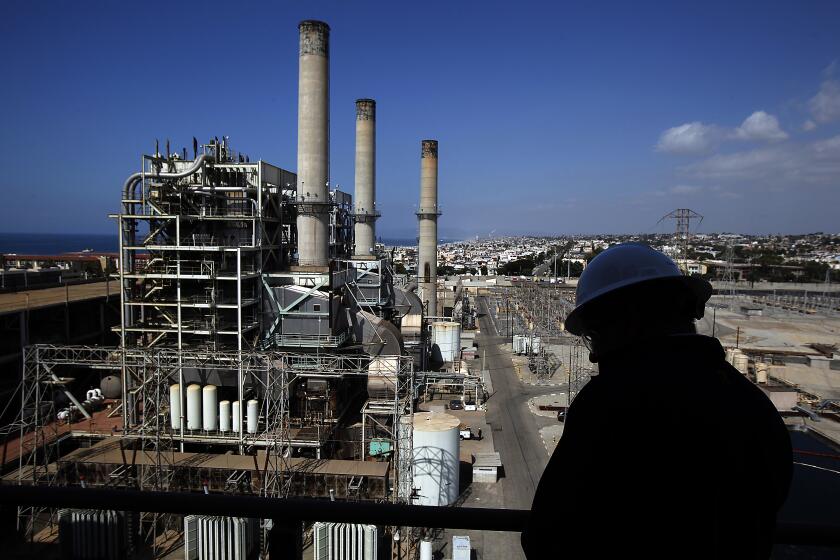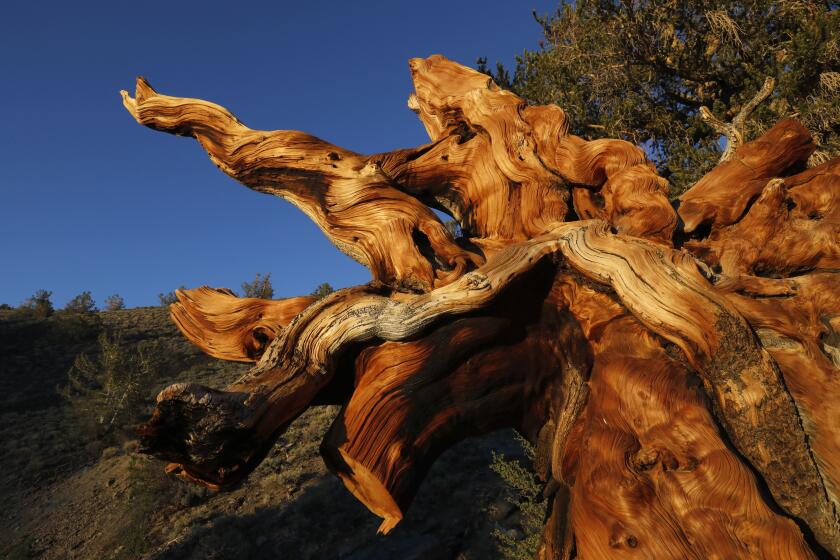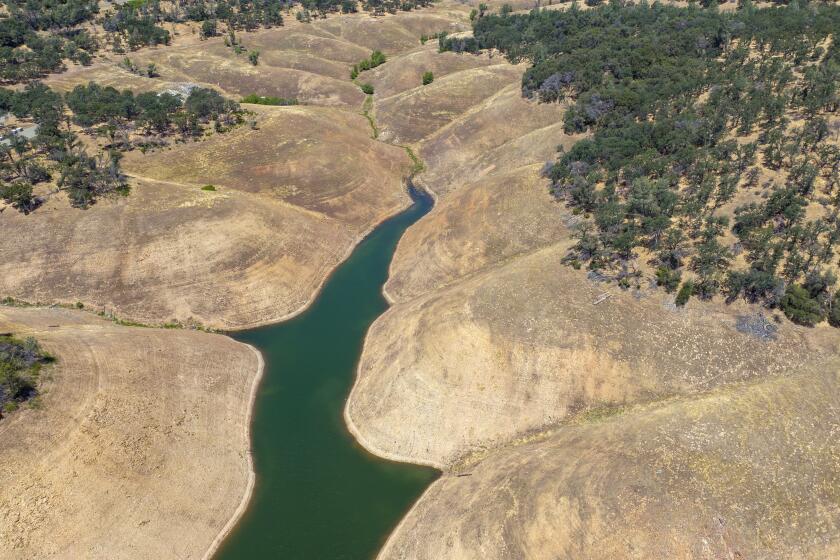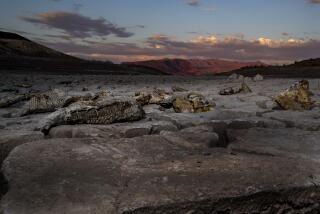Extreme heat, drought will permanently scar California and its social fabric
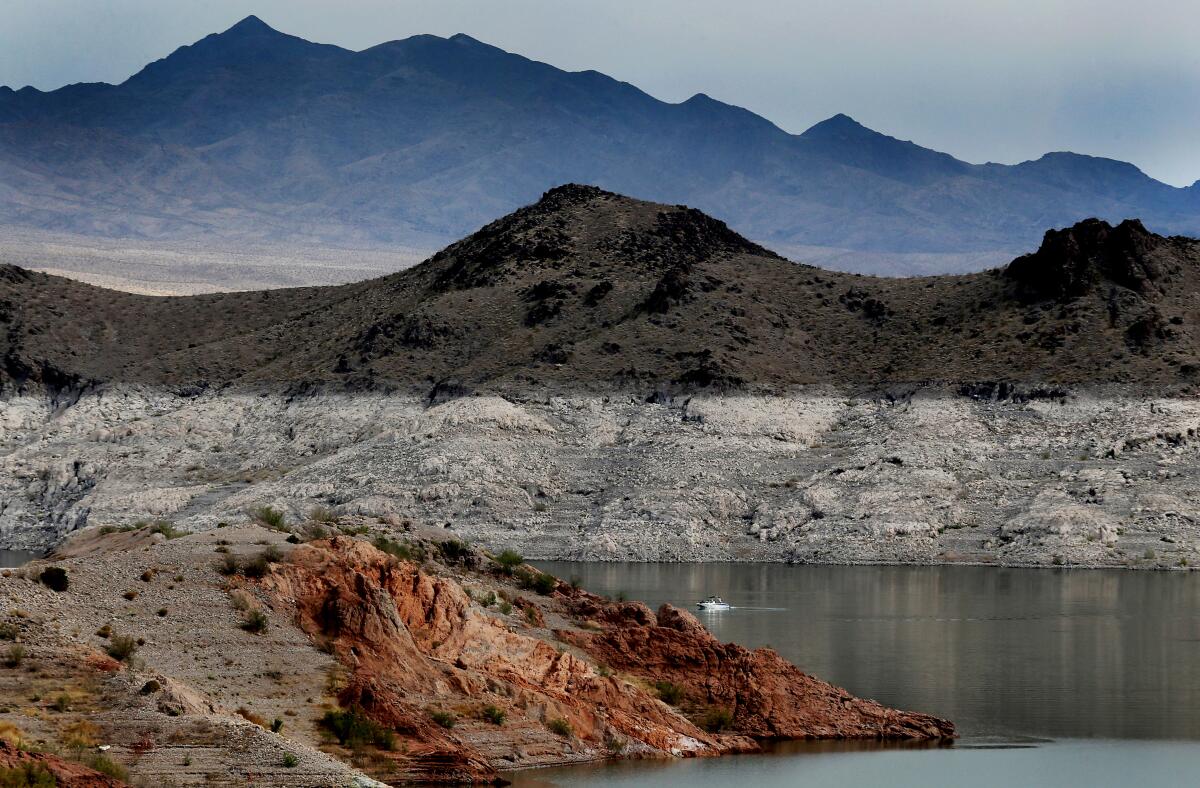
- Share via
Unprecedented dryness across the western United States is meeting with increasingly warm temperatures to create climate conditions so extreme that the landscape of California could permanently and profoundly change, a growing number of scientists say.
The Golden State’s great drying has already begun to reduce snowpack, worsen wildfires and dry out soils, and researchers say that trend will likely continue, along with the widespread loss of trees and other significant shifts.
Some say what’s in store for the state could be akin to the conditions that drove people thousands of years ago to abandon thriving cities in the Southwest and other arid parts of the world as severe drought contributed to crop failures and the crumbling of social norms.
But unlike in those ancient civilizations, California’s current transformation is being accelerated by carbon emissions and human-caused climate change, which is creating not only longer and more severe droughts, but also hotter ones. It’s a process known as aridification, and many say it’s here to stay.
“All the factors in the Southwest are leading to a drier and drier climate,” said Jonathan Overpeck, co-author of a 2020 paper on aridification. “And because they are being driven by human-caused increases in greenhouse gases in the atmosphere, we expect this drying out to just get worse and worse until we stop.”
California has entered another drought. But depending on who you ask, the last one may have never really ended.
Hundreds of years ago, the Ancestral Puebloans of what is now known as the Four Corners region of the American Southwest were a prosperous people known for their art and architecture. But sometime in the late 1200s, they abruptly abandoned their established home for reasons long considered to be a mystery.
Now, a growing body of evidence suggests that a prolonged period of dryness known as the Great Drought is to blame, at least partially, for their exodus. A similar drying has also been linked to the collapse of ancient cities in Mesopotamia and the Mayan Empire. Researchers say that can offer clues about what’s to come.
“We can use these sort of ancient, old climates to potentially learn about something that’s relevant for today,” said Jessica Tierney, a professor at the University of Arizona who studies past climates. “We know it’s going to get hotter and drier. It’s happening already. So I think the question we have to ask ourselves is, how do we adapt to those conditions?”
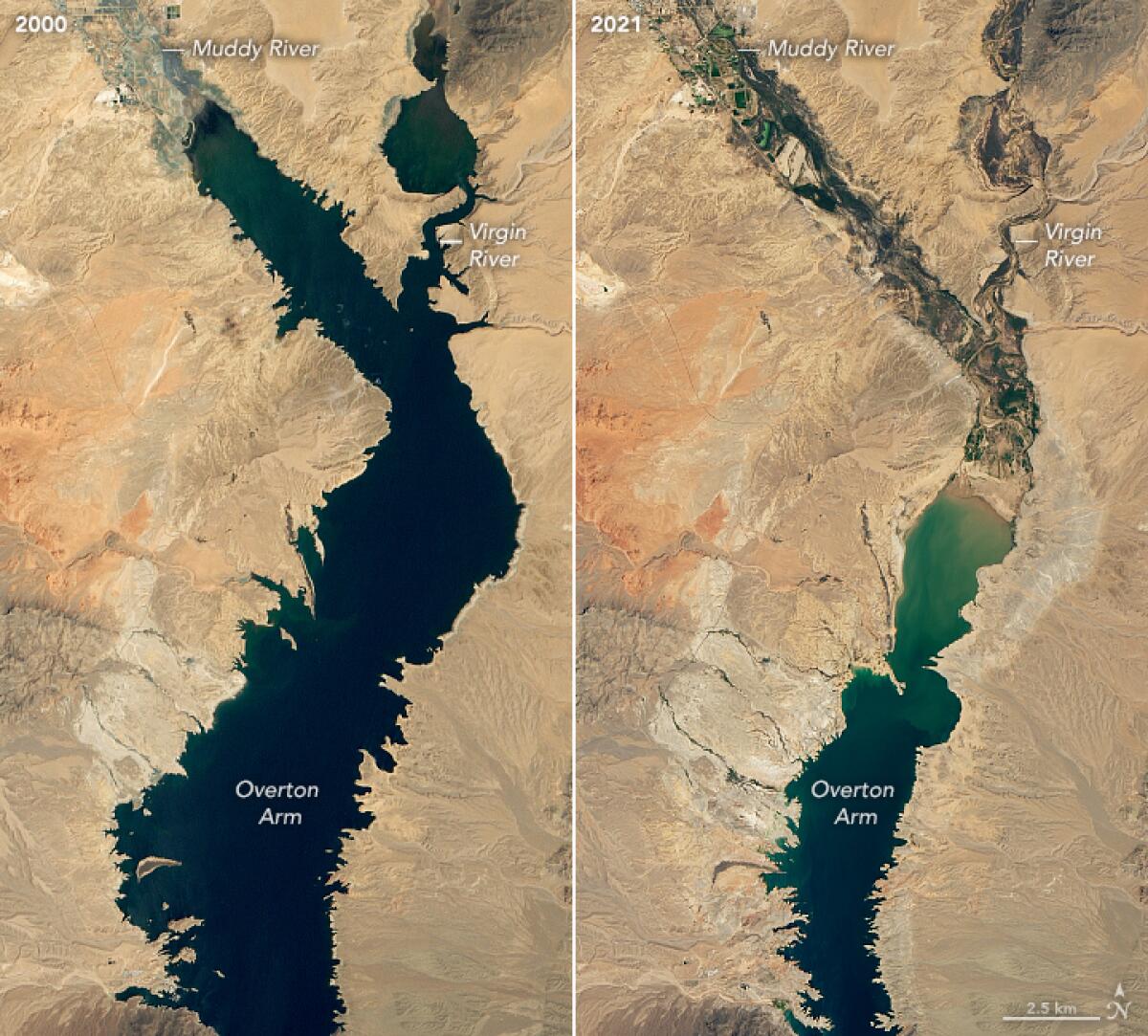
According to Tierney, part of the challenge is that while there have been megadroughts and periods of high atmospheric carbon dioxide in the past, the pace of the current warming and drying is unlike anything ever experienced.
“Ecosystems, living things, don’t have time to adjust when you change CO2 as fast as we’re changing it, and the geological record tells us that humans are changing CO2 faster than anything that we know about in the last 66 million years,” she said, adding that “our entire society was built under CO2 of just a little bit under 300 parts per million.”
Carbon dioxide levels in the atmosphere last year surpassed 419 parts per million and are continuing to climb. Tierney said living in a drier Southwest is certainly possible through adaptation, but “we just have to make smart decisions about it.”
“There were big droughts previously, like during the medieval times around 1,000 years ago ... but we’ve actually kind of surpassed that now,” she said. “We’re kind of going into this unknown territory.”
Atmospheric concentrations of carbon dioxide hit an all-time high in May despite a dip in climate pollution during the pandemic.
One important factor that distinguishes today’s conditions from those of the past is temperature, according to Matthew Kirby, a paleoclimatologist and professor at Cal State Fullerton. While drought alone is often seen as a measure of precipitation, aridification also accounts for the factor of heat.
Because average temperatures are increasing, “we’re going to start drying the soil moisture and changing the dynamics of snowpack, snowfall and rainfall,” Kirby said. “And all of that impacts water availability in ways that — without the temperature change — we might not see.”
And while drought can be a naturally occurring process tied to La Niña and other Earth systems, aridification is “without a doubt” linked to human-caused climate change, he said.
“What makes today unusual is the fact that we have humans involved. Humans weren’t changing climate 8,000 years ago, but they’re changing climate today, and that is the big unknown,” he said.
While some of what that means for California remains to be seen, parts of the process have already begun, including the steady decline of the Colorado River. Lake Mead, the nation’s largest reservoir which is located along that river, is now only 150 feet from dipping below its lowest intake valve, officials announced this month.
The West is experiencing its most severe megadrought in a millennium, according to a new study. Scientists say climate change is playing a major role.
Also likely to be affected by aridification are California’s trees. Drier soils and intense summer heat waves will worsen the two main causes of massive die-offs in Western forests: bark beetle outbreaks and wildfires, according to UCLA climate scientist Park Williams.
And because so many of the state’s forests are full of trees that were established under wetter, cooler conditions, “it is therefore very likely that when vegetation comes back after these mass tree mortality events, we’ll get something different than what was there before,” Williams said.
That means fewer conifer trees such as pines, cedars and firs in California, and more grasses and shrubs that are attuned to the drier conditions, especially at lower elevations.
The warmer atmosphere will also make more precipitation fall as rain instead of snow, affecting the timing and availability of water in the state, and will increase the likelihood of erosion as it saps moisture from plants and soil, said Williams, who recently published a study that found that the current megadrought was the driest 22-year-period in at least 1,200 years.
He likened California’s changing climate to a yo-yo on an escalator. The yo-yo is the state’s droughts, which will continue to oscillate, and may even give way to extreme precipitation events such as atmospheric rivers or floods, as in the Oroville Dam crisis in 2017.
But the escalator — aridification — is only moving in one direction: up.
“We’ll have a period of relative wetness again,” Williams said, but at the same time, “we have this slow and steady aridification trend that we do not expect to reverse any time soon.”
Extreme drought and bark beetles now threaten California’s Ancient Bristlecone Pine Forest, home to Methuselah, a 4,853-year-old bristlecone pine.
It’s not only trees and forests that will experience the shift, but also other living things, said Andrew Hoell, a research meteorologist with the National Oceanic and Atmospheric Administration’s Physical Sciences Laboratory.
“When you think of an area like the Southwest, or even semi-arid areas in California where there’s already a limited water supply to begin with, and you start decreasing that because of aridification, you’re going to change the ability of certain ecology to live there eventually,” Hoell said. “They just can’t survive.”
The Audubon Society, for example, has said that aridification of the Colorado River basin means there will be fewer available wetlands for birds. The group’s recent climate report found that 64% of North American bird species are at risk of extinction from climate change, including critical drying in the West.
Fish are also at risk as the state’s rivers get warmer and more dry. Salmon, in particular, have already been pushed to the brink of extinction in California, with officials now scrambling to release cold water supplies and even truck the fish to areas where they have a better chance at survival.
Adding to the challenge is that there’s no way to know when the current drought will end, Hoell said, meaning that “society then has to adapt to [aridification] in the midst of drought.”
“That is kind of the existential problem we’re at right now, where we’re trying to separate what is drought from aridification in the West,” he said.
While some of the promises made during the previous drought have been kept, conservation efforts are slipping as well-drilling threatens groundwater.
Despite the massive changes in store, California will still maintain its technical classification as a “Mediterranean climate,” which is based on its latitude and continental proximity to the ocean, Hoell and the other scientists said.
But that doesn’t mean humans will be spared the effects of the drying — especially when it comes to agriculture, which uses a vast majority of water in the state but also represents a huge portion of California’s economy and the nation’s food supply.
“The choice is going to increasingly be, do you want the water for the metropolitan areas and the cities, or do you want the water for the agriculture?” said Overpeck, who is also dean of the University of Michigan’s School for Environment and Sustainability.
Kirby, of Fullerton, noted that those kinds of decisions typically hit the poorest and most vulnerable people hardest.
Aridification is “certainly going to impact quality of life — it’s going to impact where, as the future goes on, you can really make a decision about living,” he said.
That doesn’t mean all hope is lost, however. Overpeck said the surest fix is cutting back on greenhouse gas emissions.
“If we want to stop aridification from getting worse, if we want to stop our droughts from getting worse, if we want to stop our water supply from declining, if we want to stop our wildfire crisis from getting worse, if we want to stop the big threat to agriculture in our region — all of those things come from acting on climate change,” he said.
Conservation and adaptation strategies can also help the state better prepare. Many projects, including those to improve infrastructure, stormwater capture and groundwater recycling capabilities, are already underway.
But while the current drought may come and go, the “upward escalator” of aridification means it is imperative that Californians learn from the past and don’t stay stuck in their old ways.
“If the state says the drought is over, act like it’s not,” Kirby said. “We’re doing a good job, but we need to live under a permanent state of water conservation because water is the final frontier — especially with the aridification in the western United States.”
- Share via
Watch L.A. Times Today at 7 p.m. on Spectrum News 1 on Channel 1 or live stream on the Spectrum News App. Palos Verdes Peninsula and Orange County viewers can watch on Cox Systems on channel 99.


